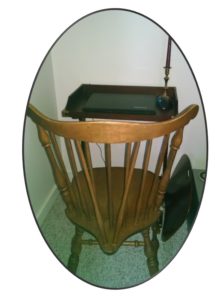Last night I found myself getting annoyed with someone being Wrong on the Internet. Instead of focusing on it, I cleaned a couple of brass candlesticks I have.
I’m looking at these candlesticks now, shining brightly in the morning light, and I got to thinking about how often I use productivity as a distraction from negative emotion.
Don’t get me wrong. I don’t consider this essentially a flaw. In fact, I consider it mostly a good thing, as it means when I am feeling something I don’t like, I can go do something else.
If, of course, there is nothing serious that needs to be done about the negative thing.
That’s the rub. There are a couple of extremes in dealing with stuff in life that I really try to avoid. The first is ruminating. I’m good at ruminating. In fact, I am so good at it that I don’t think a got a proper night’s sleep in my life until I developed the habit of listening to audiobooks to go do sleep to, and to lull me back to sleep when I wake at night.
Lest you think this is a crutch and smarm at me about what I’d do if I cannot have the audiobooks, I will point out that I did develop a non-technological solution that works just as well when needed.
I re-write the endings to books that ended in a way I didn’t like. Gone with the Wind, believe it or not, has given me endless fodder for plot points in which Scarlett gets a damn clue and grows up. This puts me back to sleep without ruminating.
Do I think that I have a tendency to pick books that have some sort of bearing on my Current Issue in some way and am actually solving a problem? Almost certainly. But the fiction gives me an emotional remove that allows me to go to sleep and let my subconscious deal with it and me to get some damn sleep.
So, I go through a lot to prevent ruminating. I’m okay with that. The alternative is pretty unpleasant.
Isn’t that sticking your head in the sand? What about Scarlett O’Hara thrusting away anything unpleasant with the whole, “I’ll think about that tomorrow” thing she did?
You do bring up a good point. This tool isn’t about ignoring problems. Notice that when I got annoyed last night and went to polish some candlesticks, that it was something I genuinely couldn’t do anything about. I’m not recommending this for things you can do something about. That would be irresponsible and it would be sticking your head in the sand about the issue.
I think the problem is at least in part our emotional makeup is very instantly reactive. In a living situation of low technology and high danger, it pretty much needs to be. That’s how we evolved, isn’t it? Being jumpy is a survival trait when you’re dealing with snakes crawling over you in your sleep and lions chasing you when you were just trying to catch dinner. Reacting with heavy emotion in a big and obvious way to the negative keeps you alive! Seeing as much of the negative as possible is likewise.
It’s not quite as useful in my air-conditioned office or upholstered living room and my full fridge.
We live in a more complex world now, and our survival trait of seeing and noticing the negative and having a serious need to do something about it RIGHT NOW just doesn’t serve as useful a purpose when problems need careful though an analysis. Nor is the emotional activation doing as much good when you’re not prepping your muscles to run away from a hippo.
That doesn’t mean that you should let things slide, though. If you have a problem, it’s fine to ask yourself, “Is this something I can do something about in this second?” Sometimes it is. And yes, the responsible thing is definitely to do something then. Do as much of the paperwork as you have the information for, make the appointment to get the car fixed, etc.
But after that? The responsible thing to do is to find something else you can do something about.
So, do I question whether or not I use chores as pseudo-productivity and an escape from something more difficult to deal with? You bet I question it!
Even so, I do think it is useful, because at least one of the problems I am dealing with isn’t unpleasant surroundings.


